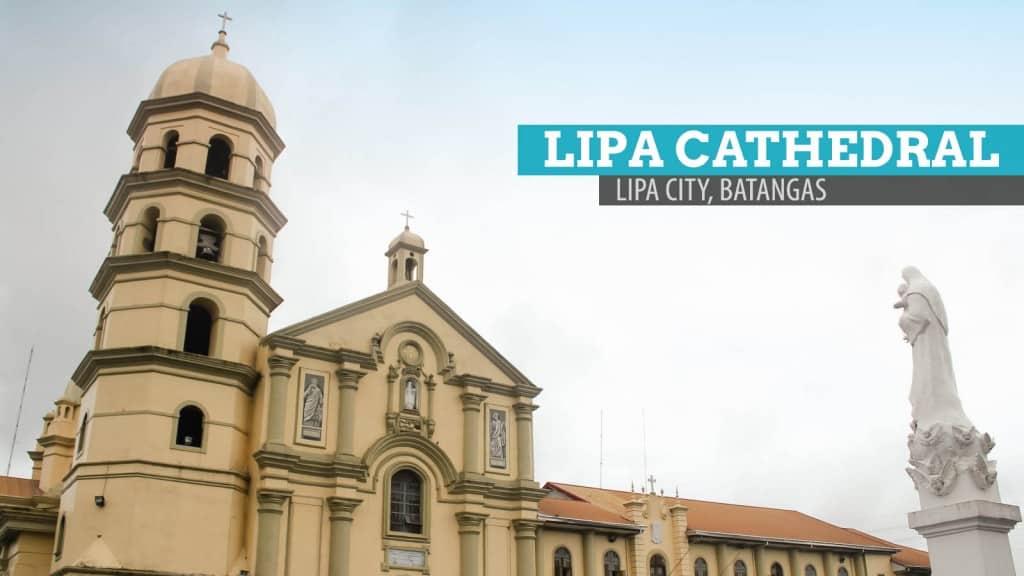I had to push my lower jaw up with my hand. I didn’t realize that the whole time I was looking up, admiring the huge, intricately painted circular dome crowning the Lipa Cathedral, that my mouth had been wide open in awe. The Poor Traveler was one of the only few people inside. It was cold and dim inside the Cathedral, like in most big churches, and the magnificent dome seemed to be the most well-lit part of the building. In fact, the dome itself illuminated the place, as most of the light inside came through its small windows, adding marvel to its already grand design.
But as one cliche goes, this dome is just the tip of the iceberg.
History of the Lipa Cathedral
The Metropolitan Cathedral of San Sebastian in Lipa, more commonly known as San Sebastian Cathedral or more simply Lipa Cathedral , has a long history of construction, destruction, and restoration.
According to the Lipa City Tourism Council, the history of the Cathedral can be traced back to as far back as April 30, 1605, when it was administered by the Augustinians under the title “Convent of San Sebastian in Comintang.” The original building was made from only light materials.
But the construction of the Cathedral that we see today started in 1779. Since then, it has undergone a series of renovations and several elements had been added until it was finally completed from 1865 to 1894, under the administration of Fray Benito Varas. In the 19th century, still according to the Lipa City Tourism Council, the towns of Lipa, Taal, Batangas, Tanauan, and Bauan competed to be chosen as the seat of the Southern Tagalog Region’s new diocese. This inspired the people of these towns to build enormous and extravagant churches. But in April 10, 1910, Lipa was chosen as the See (official seat of the bishop) and the new diocese was founded. They say that Lipa’s cool climate had a big effect on the decision by Most. Rev. Joseph Petrelli, the diocese’s first bishop. Since then, the Cathedral has also been known as the Cathedral of the Diocese of Lipa. Today, Lipa is now an archdiocese, covering many of the churches and parishes in neighboring municipalities and cities.
Lipa City was one of the most heavily destructed cities in the region after World War II. Along with many of Lipa’s ancestral houses that were destroyed, the Cathedral also suffered from the atrocities of the war. Msgr. Alejandro Olalia, however, led the restoration of this very special church in the 1950s. Many elements had been added and restored through the years.
But its history isn’t the only fascinating thing about the Cathedral.
Architecture and Design
The Lipa Cathedral was constructed in the Romanesque tradition. It has big circular dome, giant walls and columns, balconies, and arches. Standing proudly in front of the church is a bell tower, which, like the dome, is decorated with moldings.
The Main Hall is surrounded by a series of arches. The carefully arranged pews form a sea of wooden linear pattern that lies underneath the chandeliers, illuminating the church. The aisle dividing the pews lead to the altar, bathing in the spotlight provided by the clerestory of the dome above. The ceiling — including the pendentives and intrados — is painted with images of saints.
In one corner of the Main Hall is a tableau depicting the Paschal mystery. In the opposite corner is a winding stairway that connects the ground floor to the balcony, where the choir stays.
Paseo de San Sebastian
There are also a number of remarkable elements outside. Exit through the doors to the right and you’ll find a garden-like passageway called Paseo de San Sebastian. The Paseo separates the Cathedral from the administration offices. At the far end stands a figure of the Virgin Mary, surrounded by ornamental plants. While we were there we could not help but stay under the shade of the surrounding buildings and admire the fantastic architecture of the church, especially its dome that looked magnificent against the rolling clouds in the background.
Even its main entrance door is worthy of a mention. Sixteen carved images depicting the History of Salvation up to the Great Jubilee of 2000 greet devotees and tourists. The door is said to have been installed much more recently.
The San Sebastian Cathedral truly is one of the most important churches in Batangas and a trip to Lipa wouldn’t be complete without a visit to this church. It does not just provide a spiritual center and shelter to the Lipeños, it also offers a glimpse of the history of the oldest city in Batangas.
Posted: 2012 • 3 • 29
Top Hotels and Resorts in Batangas
According to Agoda review scores.
